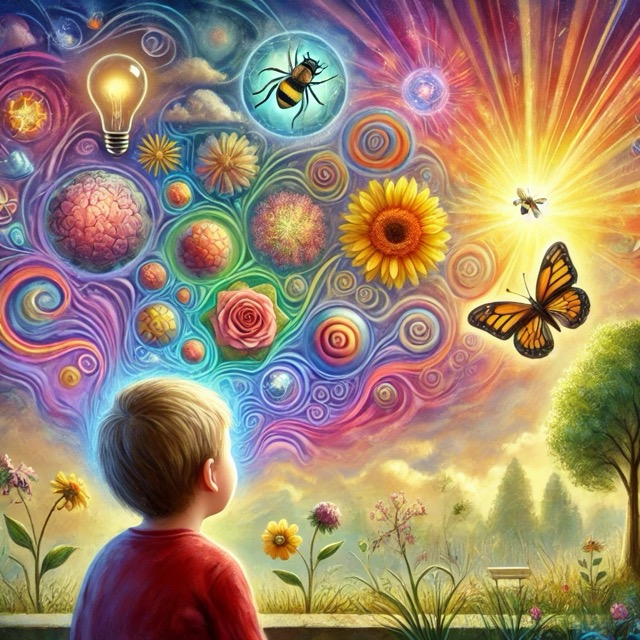Why Babies and Children Are ‘Basically Tripping’: Alison Gopnik on Childhood Consciousness


If you’ve ever watched a child marvel at a ladybug or spend hours engrossed in the intricate details of a leaf, you’ve likely caught a glimpse of what psychologist Alison Gopnik meant when she said, “The short summary is, babies and children are basically tripping all the time.” This profound statement appears in Michael Pollan’s book How to Change Your Mind, a seminal exploration of the science and culture of psychedelics, where Gopnik draws an unexpected parallel between the consciousness of young children and the altered states induced by psychedelic substances. But what does this mean? Are babies and young children really experiencing the world as if on a psychedelic journey? And how can this insight shift our understanding of both child development and human consciousness?
The Child’s Brain: A Vast Canvas of Possibilities
Alison Gopnik, a professor of psychology and a leading expert in cognitive science, has long argued that babies and young children possess an incredible openness to experience. In her research, she explores the idea that children’s minds are primed for learning in a way that adult brains simply are not. As we age, our brains develop “filters” that streamline our perception, filtering out unnecessary information so that we can focus on what’s important for survival and daily function. For adults, this filtering system is crucial—it keeps us from becoming overwhelmed by the constant influx of sensory information.
But for babies and children, these filters are not yet in place. Their brains are wide open to the world, constantly absorbing, exploring, and processing new stimuli with fewer boundaries and less preconceived notions. This state of openness and wonder is where Gopnik makes the connection to psychedelics.
When adults take substances like LSD or psilocybin, their brain activity often resembles that of a child’s. In these altered states, the filters dissolve, and people experience the world with heightened sensitivity, a sense of interconnectedness, and an awe toward even the simplest of things—much like how a toddler might be mesmerized by the way sunlight dances on the water.
What Psychedelics Can Teach Us About Childlike Consciousness
Psychedelics have been shown to reduce activity in the brain’s “default mode network,” a group of interconnected brain regions responsible for our sense of self, time, and narrative continuity. This reduction allows the brain to become more fluid, connecting regions that don’t normally communicate with each other. In a sense, it allows adults to access the kind of thinking and perceiving that comes naturally to children.
Children, whose default mode networks are not yet fully developed, are already operating in a similar state. Their minds are less focused on maintaining a coherent sense of self or a consistent narrative of the world around them. Instead, they exist in the present moment, fully immersed in whatever captures their attention at any given time.
This is why a child might get lost in a single activity for hours, fascinated by its novelty, or why they seem to experience emotions so intensely. In the same way that someone on a psychedelic journey might report feeling awe-struck by the interconnectedness of life, children are constantly in a state of discovery, perceiving things as if for the first time—because, for them, it often is.
How This Understanding Can Change the Way We Parent
Understanding that children are naturally in a state of heightened awareness and openness can transform how we approach parenting. If we view their seemingly erratic or overly emotional responses as a result of their vast, unfiltered consciousness, it may foster more patience and empathy in our parenting. Instead of seeing a tantrum over a missing toy as irrational, we can begin to appreciate that, for a child, this might feel as significant as an adult losing something precious.
This perspective shift encourages us to be more mindful of the environments we create for our children. Knowing that their brains are soaking up every experience with an almost psychedelic intensity, we might become more intentional about what we expose them to. The colors, sounds, textures, and emotional energy in their surroundings can leave lasting impressions on their developing minds.
Moreover, it highlights the importance of play and exploration. Just as a psychedelic experience can open doors to new ways of thinking and being, play allows children to explore different realities, test out new ideas, and make sense of the world in a free-form, imaginative way.
What Adults Can Learn From Childlike Consciousness
One of the most powerful takeaways from Gopnik’s analogy is the reminder that we, as adults, can benefit from reconnecting with our own childlike wonder. Over time, societal pressures, responsibilities, and the routine of daily life can close off our minds to new experiences. We become hyper-focused on efficiency, productivity, and the future, often at the expense of our ability to be fully present in the moment.
Psychedelics, in many cases, offer a temporary reprieve from these mental constraints, allowing adults to re-experience the world with the open-mindedness and curiosity of a child. But, of course, there are more accessible and safer ways to tap into this state of being. Practices like mindfulness meditation, time in nature, creative play, or simply engaging in activities without a clear goal can help us break free from the rigid patterns of adult thinking and allow us to see the world with fresh eyes.
As adults, we can also learn from the way children interact with their environment. They approach the world without the fear of judgment or failure, experimenting and making mistakes without hesitation. They follow their curiosity wherever it leads, not constrained by the “shoulds” and “shouldn’ts” that govern adult life. By embracing this mindset, even briefly, we can open ourselves up to new possibilities, both internally and externally.
The Science Behind Childlike Openness and Psychedelic States
Research into both early childhood development and psychedelic substances supports Gopnik’s claim about the similarities between these two states of consciousness. Studies show that the brains of infants and young children are characterized by an abundance of neural connections. This period, often referred to as the “critical period” of development, is when the brain is most plastic—meaning it is most capable of change and learning. During this time, children are learning about the world at an extraordinary rate, forming tens of thousands of new synapses every second.
In adults, the brain’s plasticity is more limited, and we tend to rely on established neural pathways, making learning slower and less flexible. However, psychedelic substances like psilocybin and LSD have been shown to temporarily boost neural plasticity, allowing the brain to make new connections and perceive the world in novel ways, much like a child’s mind.
A groundbreaking study published in Cell Reports (2018) demonstrated that psychedelics increase the growth of dendritic spines, the parts of neurons that receive information. This could explain why people on psychedelics often report a sense of “expanded consciousness” and the ability to think more fluidly, much like the way children approach problems with fresh, creative perspectives.
Embracing the Journey of Conscious Parenting
Alison Gopnik’s quote about babies “tripping” offers us a profound insight into the nature of both childhood and consciousness itself. Children live in a state of openness, where the boundaries between the self and the world are fluid, and every experience feels heightened and significant. Rather than dismiss this as a phase to be grown out of, we can embrace it as a reminder of what we lose as we age—and perhaps a hint at what we can reclaim through mindfulness, creativity, or even safe, guided exploration of altered states.
As parents, this insight can help us approach our children with more compassion, understanding that their emotional and sensory experiences are fundamentally different from ours. Instead of seeing their heightened reactions as something to be fixed, we can appreciate them as part of the beautiful and bewildering journey of being young and alive.
In the end, we may even learn something valuable from the way our children see the world. If we allow ourselves to let go of our filters from time to time—to see a ladybug the way a toddler does, or to feel awe at the sight of a sunset—we might rediscover that sense of magic and interconnectedness that childhood offers so freely. And in doing so, we not only deepen our bond with our children, but also with the vast, mysterious world around us.





Responses